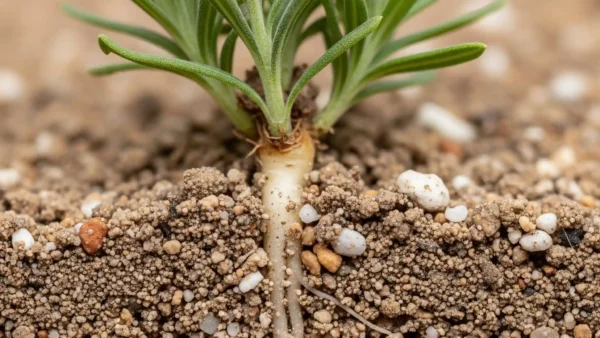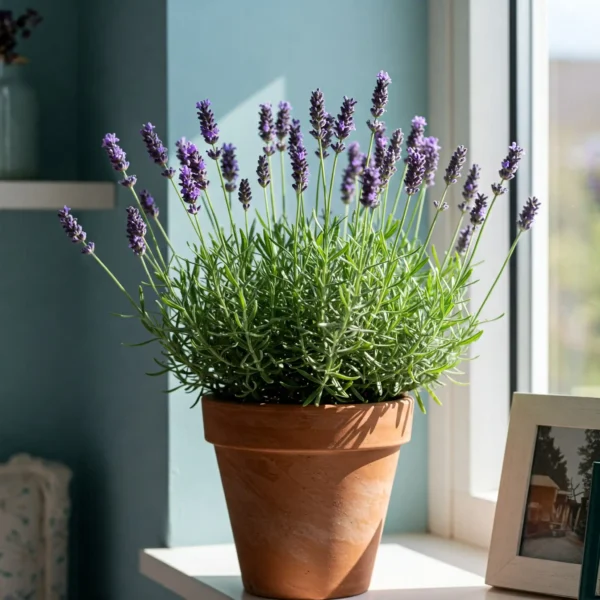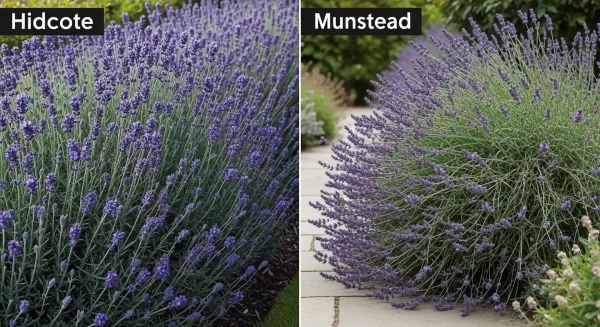The Gardener’s Essential Handbook for Lavender Spacing
Imagine a perfect lavender hedge: a series of rich, homogeneous silver mounds, each unique but flowing naturally into the next to create a fragrant, living boundary humming with the sound of contented bees. Imagine now the reverse: a jumbled, packed row where plants are battling for room, their lower leaves wilting in the shade, with bare, woody spots and a desperate, lanky grasp for the sun.
These two scenes differ in geometry rather than in luck or some secret fertilizer. It’s still in planning. Its distance is.
Of all the decisions a gardener makes, spacing is probably the one that calls most for foresight. Trusting in its genetic code to one day become a great three-foot sphere of aroma and color, this is an act of faith in the future, a promise you make to the little, modest plant you hold in your palm now.
TL;DR: The Lavender Spacing Blueprint
- The General Rule: As a starting point, space most lavender plants 2 to 3 feet apart.
- Spacing Varies by Variety: The most crucial factor is the mature width of your specific lavender type.
- English Lavenders (‘Hidcote’, ‘Munstead’): These are smaller and more compact. Space them 24 to 30 inches apart for individual mounds.
- Lavandin Hybrids (‘Grosso’, ‘Provence’): These are the giants. Give them a generous 3 to 4 feet apart to allow them to reach their full potential.
- Spanish & French Lavenders: These tend to be more upright. A spacing of 18 to 24 inches is usually sufficient.
- Why Spacing is Critical:
- Air Circulation: Prevents fungal diseases like root rot by allowing leaves to dry quickly. This is the most important reason.
- Sunlight Exposure: Ensures the entire plant, including lower leaves, gets enough sun to prevent leggy growth and woody bases.
- Root Competition: Gives each plant access to its own water and nutrients without a constant struggle.
- Designing with Space:
- For a Dense Hedge: Plant your lavender at a distance equal to its mature width (e.g., a 24-inch wide variety gets planted 24 inches on-center from the next).
- For Individual Specimen Mounds: Take the mature width and add 6 to 12 inches to the spacing to highlight each plant’s form.
So, how much room lavender actually requires to live up to that promise?
Lavender plants should be generally two to three feet apart. Still, this is merely a beginning point. The particular kind you are cultivating will determine the exact distance; equally crucial is the desired lovely appearance for your garden.
One of the most regularly occurring and difficult-to-reverse gardening errors is improper spacing, which usually causes a domino effect of issues ranging from illness to weak plants to a design that deviates from your vision. But not to worry though. This guide will offer a whole blueprint, including all the Lavender Spacing Requirements, so ensuring that your garden idea becomes a long-lived, attractive, and healthy reality.
All set to go beyond speculation and learn how to arrange your lavender like a professional designer? Let’s plant once after two measurements.
More Than Just Elbow Room: The Research Behind Correct Lavender Spacing
We really need to know why space is so vital before we start the tape measure. Based on the basic, non-negotiable demands of the plant, this is not a random guideline designed to complicate gardening. Knowing the “why” will help you to be a better, more naturalist gardener.
The first reason is air circulation.
The worst foe of lavender is dampness sitting on its head and leaves. It hates still, humid weather and evolved on the rocky Mediterranean hillsides in breezy, arid conditions. Plants close together cannot allow unrestricted air passage between them. This leaves a pocket of trapped humidity, particularly in early morning’s heavy dew or following rain. Fungal infections like the ultimate killer, root rot, gray, fuzzy mold of Botrytis blight, and the floury-white powdery mildew find ideal habitat in this still, moist environment.

Consider correct spacing as your plants’ social distance. It lets a little wind flow through, rapidly drying the leaves and whirling away humidity before fungal spores can get hold. The best natural fungicide you can offer is good spacing.
Optimizing Sunlight Exposure
Lavender sun worshippers, through and through. Not only the very top, but all of it depends on solar. Plants crowded closely produce a dense “canopy effect.” The lower two-thirds of the plant are cast into shadow; the top leaves create a broad umbrella that absorbs all the sun. These lower leaves will turn yellow, wither, and drop without direct sun, therefore producing bare, woody stalks. Each plant will then respond by a desperate upward reach for light, a phenomenon known as etiolation, producing a “leggy,” top-heavy, and ugly look instead of the full, bushed mound you want.
Stopping Root Competition
Although the fight for light takes place above ground, another equally vital fight is under way below. The roots of crowded plants become a twisted, entwined mass under the soil. For the same little supplies of water and nutrients, they are caught in an invisible, relentless tug-of-war. Constant rivalry causes chronic stress, which inhibits development, lowers floral production, and weakens the plant’s natural defenses, hence increasing its susceptibility to pests including aphids and spider mites that feed on stressed plants.
Room to Reach Mature Dimensions
The little, lovely 4-inch plant you carry home from the nursery is only a baby. Its final, developed size is determined by a genetic code. Appropriate distance shows regard for that future. It provides the physical space the plant requires to flourish into its full, magnificent potential free from neighbor bullying, choke-out, misshapener action. A plant that has room to grow organically develops a stronger central stem and better branching structure, therefore increasing its resilience to the weight of heavy snow or torrential rain that can split a crowded, weaker plant right down the middle.
How far apart should you space Lavender plants? a Useful Manual
Let us now get right to the figures. The particular kind of lavender you are planting determines spacing most importantly as their mature sizes vary greatly.
Variations in spacing depending on kind
- English lavenders (Lavandula angustifolia) such as “Hidcote,” “Munstead,” and “Vera”: Usually the smaller, more compact, and orderly mounded plants most people image when they consider lavender. Space them 24 to 30 inches apart for developing them as solitary specimens where you wish to highlight their classic form.
- Lavandin Hybrids (Lavandula x intermedia) like “Grosso,” “Provence,” and “Phenomenal,” prefer Here are the lavender world’s giants. Often sought for their long stems for crafts, they are far bigger, more energetic plants that create amazing, spreading mounds. They need much more space to themselves to keep from turning into a jumble. Space them a generous 3 to 4 feet apart to let them reach their best without overwhelming one another.
- Spanish and French lavenders (Lavandula stoechas & L. dentata) comparatively to its cousins, often have a more straight, less spreading growth pattern. Usually, a distance of 18 to 24 inches will be plenty to provide them the space they need to display their unusual leaf and floral forms.
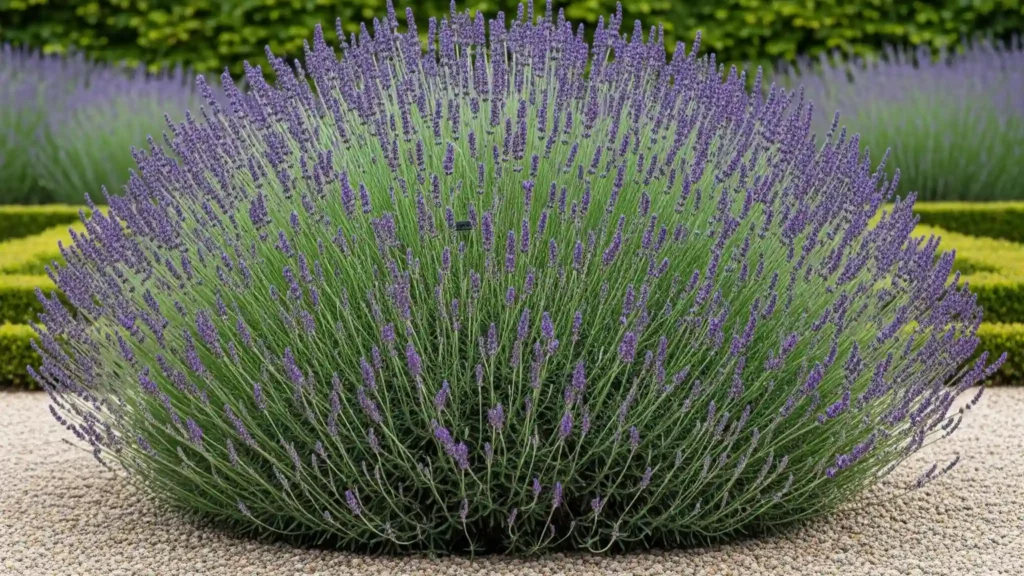
The Idea of “On-Center” Distance
When a landscape designer or horticulturalist advises place plants “24 inches apart,” they are saying that the distance between one plant’s central stem and the central stem of the next should be 24 inches. The standard for arranging plants in any design is this professional term, “on-center” spacing. Using your tape measure, picture marking a line from the exact center of the trunk of the first plant to where the trunk of the next plant will be. That’s your measurement line. Measure not from one plant’s edge to the next; this will vary as the plant grows and result in erroneous spacing.
Designing with Lavender: How Space Creates Various Garden Styles
Spacing is a great design element that lets you create certain, deliberate looks in your garden; it is not only about plant health. Just by varying their distance, one can produce rather varied effects from the same plant species.
Regarding a Dense, Formal Hedge
Planting them somewhat closer together than you would with individual specimens will help you to produce a seamless, connected hedge where the separate plants combine into a single, flowing river of silver and purple. When they become adults, the aim is for them to “hold hands”. The approach is straightforward: Choose your on-center distance from the mature width of your selected variety.
For instance, you should arrange the plants exactly 24 inches on-center if the tag on your ‘Munstead’ lavender indicates it grows 24 inches wide. This guarantees that their leafy margins will just touch to create that ideal, continuous hedge effect when they are fully grown. Common mistake that will cause crowding and disease down the road is planting any closer.
For “Specimen” Planting, Individual Mounds
Space each plant wider apart if you wish to enjoy their exquisite, mounded design. For a gravel garden, a modern minimalist landscape, or a xeriscape design in which every plant is a living sculpture, this is a fantastic look. Taking the mature width of the plant, add six to twelve inches to it.
Space and rhythm in the garden will be highlighted by spacing the plants 30 to 36 inches apart for that same 24-inch-wide “Munstead,” thereby leaving a beautiful river of mulch or stone between each unique silver mound.
For a Mass Planting Naturalistically
You should avoid planting in strict, straight rows if you want a dreamy, cottage-style “sea of lavender” that resembles what nature’s hand on a sun-drenched hillside created. Rather, arrange things staggered, triangle-style. Consider grouping three plants in triangle instead of a square. This produces a more natural, less stiff, and wonderfully textured impression by breaking up the strong lines. To further the realistic impression, you can even alter the distance somewhat between plants—some at 24 inches, some at 30 inches.
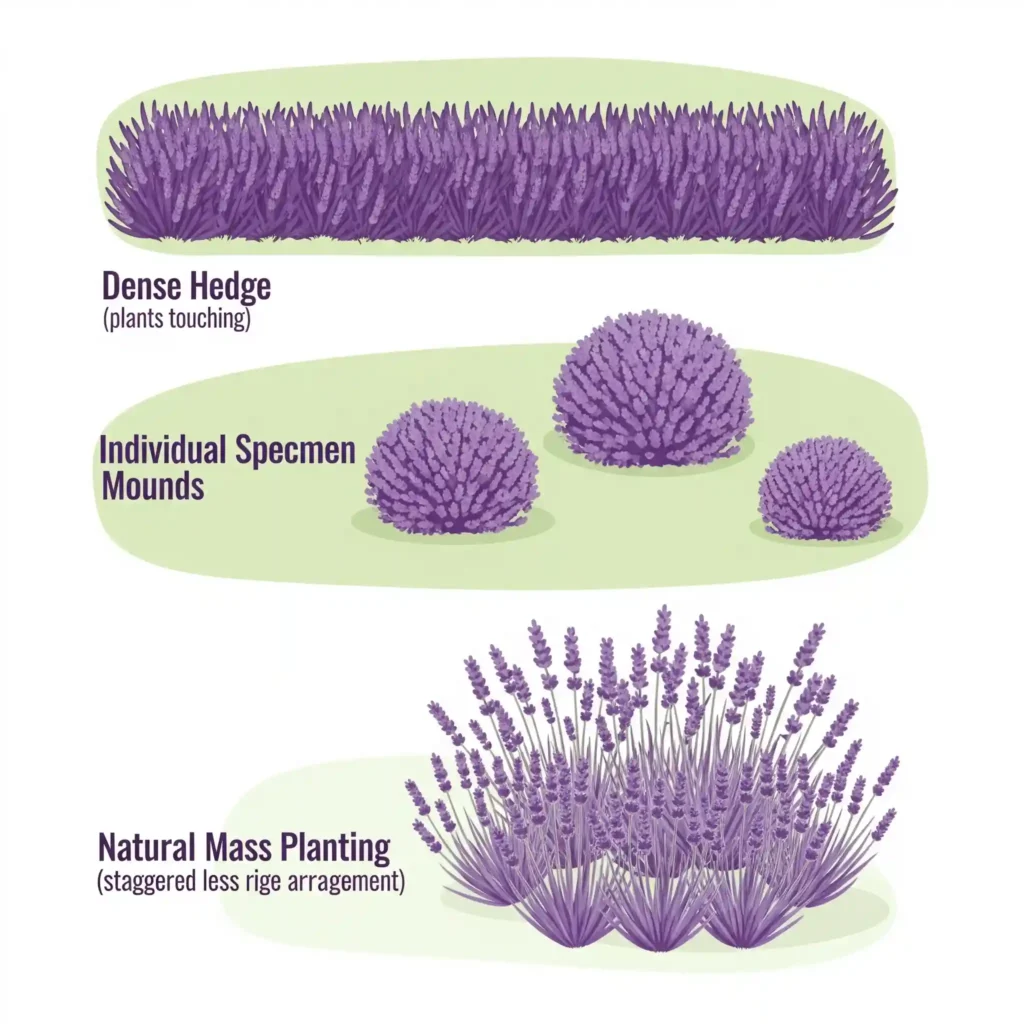
When Good Plants Grow in Bad Areas: How to Find and Correct Spacing Errors
Even the greatest of us could overestimate the ultimate scale of a plant. Here’s how to find out whether your spacing is problematic and what to do about it.
The problems with planting too close will show up in the second or third year once the plants start to grow and demand the space they were promised. Usually starting on the lower leaves, a floury, white covering called powdery mildew results from inadequate airflow. After rain, you may also detect a musty scent that doesn’t clear fast. As the plants fight for light, they will grow taller but thinner; if you peep inside the hedge, you will see the centers may be fading out from lack of air and sun, producing a hollow “donut” shape.
Fix Overcrowded Lavender: The only genuine fix is to be bold and forceful. Early spring is the ideal time to get involved as fresh development starts to show. Dig up and move every other plant in the row carefully to a fresh, appropriately spaced spot. To reduce the time their roots are exposed to the air, ready the new holes before you start excavating the plants. Initially it will seem agonizingly scant, and you might feel as though you have destroyed your hedge, but don’t give up. Suddenly free from competition, the surviving plants will thank you with an explosion of vigorous, healthy growth and probably fill in the area by the end of the season.
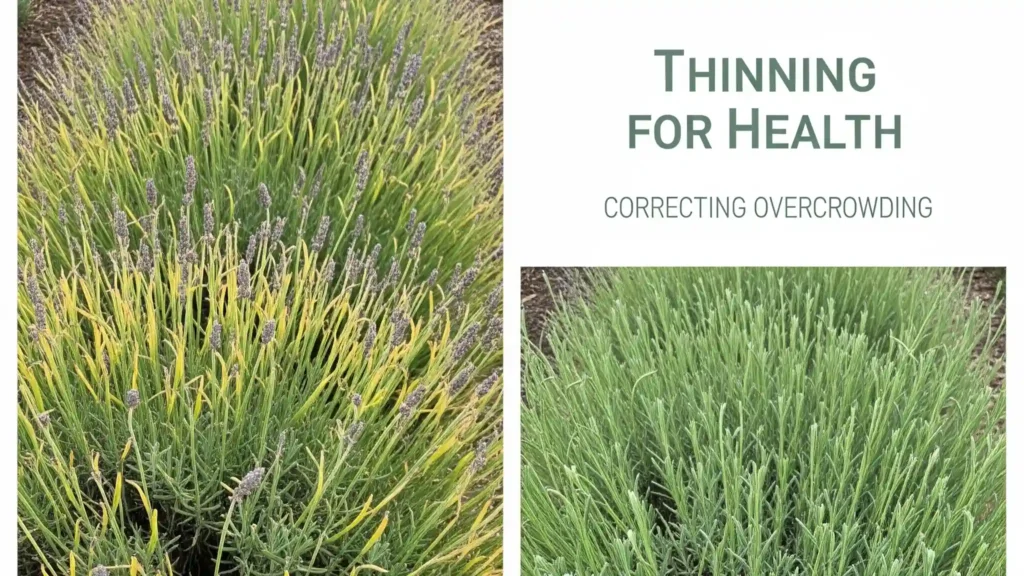
Planting too far apart causes only aesthetic problems; it has no bearing on health issues. Your plants will be absolutely content and healthy. Your design, though, can seem unfinished. Should you be looking for that thick, flawless hedge and space your plants too far apart, you will simply have a row of individual “meatballs” with significant permanent gaps between them. Planting young lavender in the gaps will help to fill in the void; be aware that the new plants will be smaller for a few seasons until they catch up.
Last Thought
Correct distance is a forethought act. You present this gift to your future self as well as to your garden. Planting day is an investment you make—a few extra minutes with a tape measure—that pays off for the lifetime of your lavender, producing healthier plants, more plentiful blooms, and a more attractive, deliberate design.
Keep in mind your final design aim as well as the mature size of your particular variety. Measure once; twice is plant. Mastery of these Lavender Spacing Requirements will help you to design with lavender rather than just plant it.
Often asked questions
Could I plant lavender closer together to achieve a rapid full hedge look?
Although it’s rather tempting to fool the system in search of a faster outcome, this is a typical error nearly always backfires. For one season the plants will look fantastic; but, by year two or three they will become a crowded, tangled mess and cause intense competition for resources that causes disease and poor, lanky development. The next five years will be spent battling issues rather than enjoying your hedge. Correct spacing them for their mature size is always ideal, and exercise some patience. A well spaced hedge will remain healthy for years to come and fill in exquisitely.
How big should my lavender be mature-wise?
Your companion in plants is the tag! A respectable nursery would always specify the anticipated mature breadth and height for that particular cultivar. Should the tag be absent or you have forgotten, a fast internet search for your variation—e.g., “Lavandula ‘Grosso’ mature size”—will provide the solution. Calculate all of your spacing from this mature width.
Does lavender grown in humid climates have different spacing?
Indeed, it’s even more vital! Living in a humid area like the Midwest or the Southeast always means err on the side of greater room. Generally speaking, you should raise the recommended gap by roughly 25%. Give it a full 30 inches if the tag advises 24 inches. Your best line of protection against the fungal illnesses that flourish in moist, sticky air is those additional six inches of ventilation.
How near should I place other plants to my lavender?
Use the same exact idea. Find out the companion plant’s mature size and make sure its ultimate spread won’t crowd the lavender and impede its valuable sun or airflow. Those that enjoy lavender’s love of sun and dry soil are the best friends. Excellent choices are low-growing, drought-tolerant companions including creeping thyme, ice plant, some sedums, and ornamental grasses like Blue Fescue as their footprint is modest and they won’t compete for space or provide unwelcome shadow.



